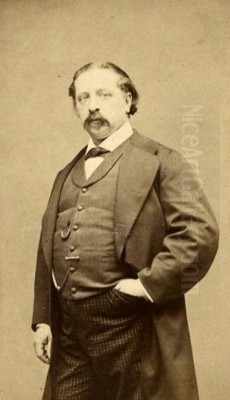
Benjamin Eugene Fichel stands as a significant figure in the landscape of 19th-century French art. Born in Paris on August 30, 1826, and passing away in the same city in 1895, Fichel carved a distinct niche for himself as a painter specializing in meticulously detailed historical genre scenes, particularly those evoking the elegance and intrigue of the 18th century, as well as pivotal moments from the French Revolution and the Napoleonic era. His work, deeply rooted in the academic tradition, found favour within the influential Paris Salon system, earning him accolades and a dedicated following among collectors who appreciated his technical finesse and evocative storytelling.
Fichel's artistic journey began within the hallowed halls of the École des Beaux-Arts in Paris, the epicentre of academic art training in France. There, he benefited from the tutelage of two prominent masters: Paul Delaroche and Martin Drolling. Delaroche, renowned for his dramatic historical paintings often characterized by a polished finish and theatrical staging, undoubtedly imparted a sense of historical narrative and precision. Drolling, known for his intimate interior scenes and portraits, likely influenced Fichel's handling of light and detail within enclosed spaces. This rigorous academic training provided Fichel with a strong foundation in drawing, composition, and the traditional techniques valued by the art establishment of the time.
Debut and Recognition at the Paris Salon
The Paris Salon was the paramount venue for artists seeking recognition and patronage in 19th-century France. Acceptance into its annual exhibitions was crucial for career advancement. Fichel made his official debut at the Salon in 1849, presenting three works that hinted at the range of his early interests: a religious painting titled Holy Family, and two portraits, Portrait de Haji-Addi-Ham-Bey and Portrait de M.L. This initial showing marked the beginning of a long and consistent presence at the Salon, where he would exhibit almost annually for several decades.

Fichel's dedication and skill did not go unnoticed. The Salon juries, arbiters of taste and bestowers of official honours, recognized his talent with several awards. In 1857, he received a Third Class medal, a significant acknowledgment, reportedly for his painting Une Matinée Dramatique (A Dramatic Morning). He achieved this distinction again in 1861, possibly for Première Leçon d’Armes (First Weapons Lesson). Further accolades followed, including another medal in 1862 for Ambulants Danseurs dans Un Cabaret (Travelling Dancers in a Tavern) and a 'New Medal' or rappel in 1869 for Baptême de Mme Clairon (The Baptism of Madame Clairon). His participation in the great international exhibitions also brought honours; he was awarded a silver medal at the Exposition Universelle in Paris in 1889. The culmination of this official recognition came in 1870 when he was named a Chevalier of the Legion of Honour, a prestigious state decoration acknowledging his contributions to French art.
Artistic Style: Precision, Detail, and Historical Evocation
Benjamin Eugene Fichel's style is characterized by its remarkable precision, meticulous attention to detail, and a clear affinity for historical subjects rendered on an often intimate scale. His approach aligns closely with the academic tradition, emphasizing fine finish, careful drawing, and balanced compositions. He became particularly known for his small-scale panel paintings, which invited close inspection to appreciate the intricate rendering of costumes, furniture, and facial expressions.
A defining aspect of Fichel's work is its connection to the style of Jean-Louis-Ernest Meissonier, one of the most successful and highly paid artists of the Second Empire. Meissonier was celebrated for his incredibly detailed small-scale historical and military scenes, often depicting 17th and 18th-century gentlemen or Napoleonic soldiers. Fichel clearly admired Meissonier's technical virtuosity and thematic choices. Both artists shared a passion for historical accuracy, investing considerable effort in researching period details to ensure authenticity in their depictions of clothing, weaponry, and interiors. Fichel is often considered a follower or emulator of Meissonier, operating within a similar aesthetic framework.
While the influence of Meissonier is undeniable, Fichel developed his own nuances. Some contemporary and later critics noted subtle differences, occasionally suggesting Fichel's colour palette might be slightly softer or his compositions less rigidly structured than Meissonier's at times. However, the core similarities remain strong: a commitment to high finish, detailed realism, and the narrative potential of historical genre. This stylistic kinship placed Fichel firmly within a popular and commercially successful vein of academic painting during his lifetime, though Meissonier consistently achieved greater fame and commanded higher prices.
Thematic Focus: Echoes of the 18th Century and Napoleonic Lore
Fichel's oeuvre is dominated by scenes drawn from French history, with a particular fondness for the 18th century – the era preceding the Revolution – and the period of Napoleon Bonaparte. He seemed captivated by the social rituals, intellectual gatherings, and dramatic moments of these bygone times. His paintings often depict gentlemen in powdered wigs and elaborate coats engaged in conversation, playing chess, examining artworks, or participating in musical interludes within richly appointed interiors. These works evoke a sense of nostalgia for the Ancien Régime's elegance and sociability.
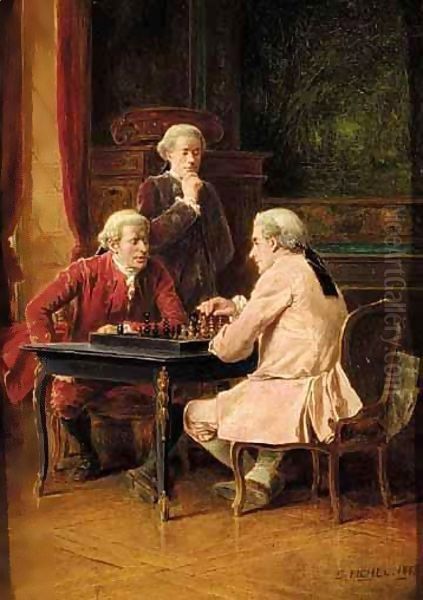
Works like Les Encyclopédistes à la Bibliothèque du Roi (The Encyclopedists at the King's Library) from 1860 exemplify his interest in the intellectual ferment of the 18th century. He meticulously recreates the setting and portrays figures suggestive of the era's great thinkers, capturing a moment of scholarly exchange. Similarly, paintings depicting artists in their studios, connoisseurs admiring collections, or scenes set in taverns and private salons allowed Fichel to explore human interactions and showcase his skill in rendering diverse textures and details.
The Napoleonic era provided another rich source of inspiration. Fichel painted numerous scenes featuring Napoleon Bonaparte himself or events related to his campaigns and governance. Napoleon dans son cabinet de travail (Napoleon in his Study), exhibited possibly around 1864, shows the emperor absorbed in his work, a portrayal aiming for historical intimacy rather than battlefield grandeur. Another significant Napoleonic work, shown at the 1865 Salon, depicted Napoleon I Reorganizing Tactics (sometimes titled based on its location, Palais de Compiègne). This painting was notably purchased by Princess Mathilde Bonaparte, a cousin of Emperor Napoleon III and an influential patron of the arts, highlighting Fichel's appeal within high society. Another work mentioned is Le Général Napoléon à l'Académie de peinture, suggesting an interest in Napoleon's relationship with the arts or perhaps depicting a specific historical anecdote.
Beyond these specific historical periods, Fichel also tackled dramatic historical events. His painting for the 1865 Salon, La Nuit de 24 août 1572, avant les massacres (The Night of August 24, 1572, Before the Massacres), delved into the tense moments preceding the St. Bartholomew's Day Massacre, showcasing his ability to handle scenes of historical gravity. Ouvrez au Nom du Roi (Open in the Name of the King), exhibited at the 1867 Salon, likely depicted a scene of arrest or official intrusion, again drawing on historical drama.
Technique and Comparisons: Echoes of the Dutch Masters
Fichel's meticulous technique, particularly his handling of light, texture, and detail within interior scenes, often drew comparisons to the Dutch Golden Age masters of the 17th century. Artists like Gerard ter Borch, Gabriel Metsu, and Pieter de Hooch specialized in intimate genre scenes rendered with exquisite precision, capturing the play of light on different surfaces – silk, velvet, wood, metal – and conveying subtle psychological nuances in their figures.
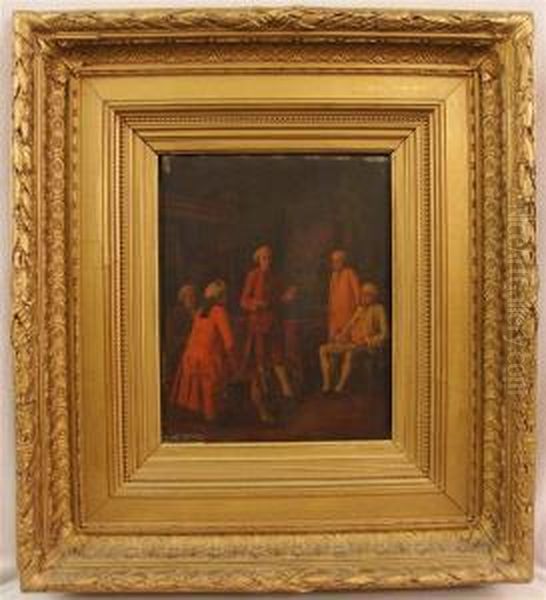
Fichel's work shares this appreciation for the tangible quality of objects and the careful orchestration of light to define space and mood. His ability to render the sheen of a satin waistcoat, the intricate pattern of a carpet, or the reflective surface of polished wood echoes the technical prowess of these earlier Dutch painters. This connection was likely intentional, as the Dutch masters were highly esteemed in the 19th century, and aligning oneself with their tradition lent an air of classical skill and refinement. Works like Les Cavaliers Castillans (The Castilian Horsemen) (1883) and Le Déjeuner (The Luncheon) (1888) continued to demonstrate this capacity for detailed, intimate observation, reminiscent of Dutch cabinet painting traditions.
His compositions are typically well-balanced and carefully staged, guiding the viewer's eye through the narrative elements within the scene. Figures are clearly delineated, and their poses and expressions contribute to the story being told, whether it's a quiet game of cards, a lively discussion, or a moment of historical significance. The overall effect is one of clarity, order, and accomplished craftsmanship, fully aligned with the aesthetic values promoted by the French Academy and the Salon.
Fichel and His Contemporaries: Collaboration and Competition
The Parisian art world of the mid-to-late 19th century was a vibrant but competitive environment. Fichel navigated this world primarily through the established Salon system. His training under Delaroche and Drolling placed him within a lineage of respected academic painters. His stylistic proximity to Meissonier put him in direct comparison, and likely competition, with one of the era's most successful artists. While Meissonier achieved superstar status, Fichel maintained a highly respectable career, consistently exhibiting and selling his work.
He exhibited alongside a vast array of artists at the Salon, reflecting the diverse artistic production of the time. This included other highly successful academic painters who specialized in historical or genre scenes, such as Jean-Léon Gérôme, known for his Orientalist and historical subjects executed with photographic precision; William-Adolphe Bouguereau, famed for his idealized mythological and peasant scenes; and Alexandre Cabanel, another pillar of the academic establishment, favoured by Napoleon III. Fichel's work shared the academic emphasis on technical skill and narrative clarity with these artists, even if his subject matter and scale often differed.
He also exhibited alongside artists exploring different facets of historical painting, like Adolphe Yvon, known for large-scale battle scenes, or contemporaries focusing on genre, such as Augustin Feyen-Perrin, with whom Fichel's work appeared in the 1865 Salon. The art world also included figures like Gustave Doré, whose prolific output spanned illustration and painting, often with a dramatic or fantastical bent, and James Tissot, who explored modern life and society genre scenes with a detailed finish that sometimes paralleled academic techniques.
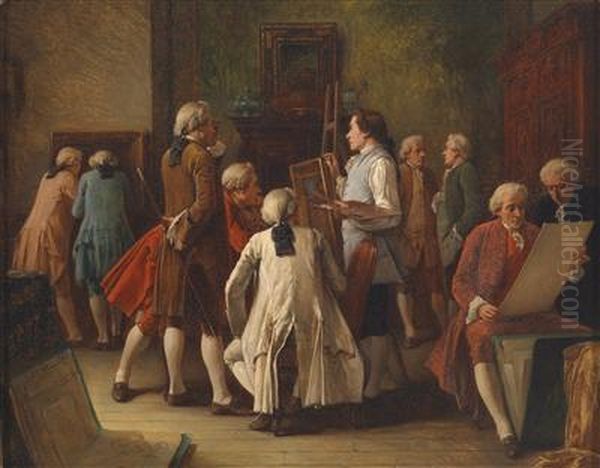
Fichel's career unfolded against the backdrop of emerging challenges to the academic system, most notably Realism championed by Gustave Courbet, and later, Impressionism led by artists like Claude Monet, Edgar Degas, and Pierre-Auguste Renoir. While Fichel remained steadfastly within the academic tradition, his meticulous style, focused on historical subjects, represented a distinct and commercially viable path, contrasting sharply with the avant-garde's explorations of modern life, light, and subjective perception.
Later Life, Legacy, and Anecdotes
Fichel continued to paint and exhibit throughout his later years, producing works like Au Café (At the Café) and Partie des Dames (Ladies' Departure), suggesting a continued interest in social observation, albeit perhaps shifting towards more contemporary or generalized genre themes alongside his historical specializations. He remained a respected figure within the art establishment until his death in 1895.
Anecdotal evidence suggests Fichel was a man of some piety. One account mentions him purchasing a private residence specifically to facilitate more devout religious observance, painting a picture of a man concerned with spiritual matters alongside his artistic pursuits. This glimpse into his personal life adds a layer to the understanding of the artist behind the meticulously crafted canvases.
Benjamin Eugene Fichel's legacy lies primarily in his contribution to the historical genre painting tradition in 19th-century France. He was a master technician, admired for his "archaeological precision" and his ability to bring historical moments to life with vivid detail and narrative skill. While heavily influenced by Meissonier, he carved out his own successful career, satisfying the public's and collectors' appetite for finely wrought scenes of elegance, intrigue, and historical significance.
His work played a role in the 19th-century revival of interest in 18th-century aesthetics and history, providing visual touchstones for a period viewed with a mixture of nostalgia and fascination. While not an innovator in the mould of the Impressionists or other avant-garde figures, Fichel represents the enduring strength and appeal of the academic tradition during a period of significant artistic change. His paintings remain valuable documents of 19th-century taste and stand as testaments to a remarkable level of craftsmanship dedicated to the evocative power of history painting.
Academic Reception and Conclusion
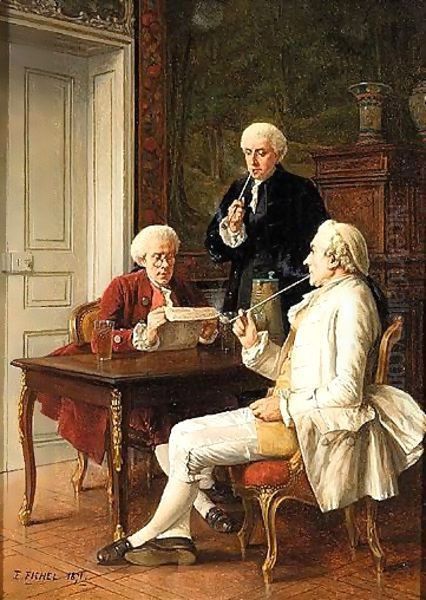
Scholarly and critical assessment of Benjamin Eugene Fichel generally acknowledges his exceptional technical skill, his mastery of detail, and his significant success within the Salon system. Contemporary critics often praised his harmonious colour, precise drawing, and the engaging quality of his historical narratives. He was frequently lauded for the finesse comparable to Meissonier, even if sometimes positioned as a talented follower rather than a leader. His works were seen as embodying the high standards of finish and historical verisimilitude valued by the Academy and a large segment of the art-buying public.
In art historical studies, Fichel is recognized as a key representative of the historical genre specialization within 19th-century French academic art. His focus on the 18th century and the Napoleonic period, rendered with meticulous detail, places him firmly within the context of historical revivalism and the broader academic production of the Second Empire and early Third Republic. His consistent presence and success at the Salon underscore the enduring appeal of this style of painting, even as more radical artistic movements were emerging.
In conclusion, Benjamin Eugene Fichel was a highly accomplished French painter whose career was defined by his dedication to historical genre. Trained by masters like Delaroche and Drolling, and heavily influenced by the celebrated Meissonier, he excelled at creating detailed, evocative scenes drawn from the 18th century and the Napoleonic era. A recipient of numerous Salon awards and the Legion of Honour, he enjoyed considerable success and patronage. While not a revolutionary figure, his meticulous craftsmanship, historical accuracy, and engaging narratives secured him a lasting place as a significant practitioner within the rich tapestry of 19th-century French academic art. His works continue to be appreciated for their technical brilliance and their charming, detailed glimpses into bygone eras.